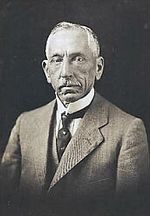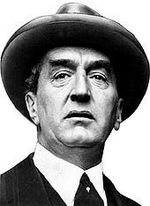Nationalist Party of Australia facts for kids
Quick facts for kids
Nationalist Party of Australia
|
|
|---|---|
| Leader | Billy Hughes, Stanley Bruce, John Latham |
| Founded | 1917 |
| Dissolved | 1931 |
| Preceded by | Commonwealth Liberal Party National Labor Party |
| Succeeded by | United Australia Party |
| Ideology | Conservatism Nationalism |
| Political position | Centre-right |


The Nationalist Party of Australia was an important political party in Australia. It started on 17 February 1917. This happened when two other parties, the Commonwealth Liberal Party and the National Labor Party, decided to join forces.
The Nationalist Party was in charge of the government until 1929. It was also the main group that opposed the Labor Party. In 1931, the Nationalist Party joined with a group of politicians who had left the Labor Party. This new group was led by Joseph Lyons and became the United Australia Party. This party later helped form the Liberal Party of Australia in 1944.
Contents
How the Nationalist Party Started
In October 1915, Australia's Prime Minister, Andrew Fisher, retired. The Australian Labor Party (ALP) chose Billy Hughes to be the new leader and Prime Minister. Hughes strongly believed Australia should take part in World War I.
After visiting Britain in 1916, Hughes thought Australia needed to force people to join the army. This idea is called conscription. However, most of his own party, especially the trade unions, did not agree with conscription. Many Irish Roman Catholics in the Labor Party also did not want to support the British government. This was because of how Britain treated Ireland during the Easter Uprising of 1916.
The Conscription Debate
In October 1916, Hughes held a special vote called a plebiscite. He wanted Australians to support conscription. But the idea was voted down by a small number of votes. Melbourne's Catholic Archbishop, Daniel Mannix, was a big opponent of conscription.
Hughes kept pushing for conscription. This caused a deep and angry disagreement across Australia. It also caused a big split within his own Labor Party.
Hughes Leaves the Labor Party
On 15 September 1916, the Labor Party in New South Wales forced Hughes out of the party. Later, on 14 November 1916, the federal Labor members met. There was a lot of arguing.
Hughes and 24 other Labor members walked out of the meeting. The remaining 43 members then voted that they no longer trusted Hughes as their leader. This removed Hughes and his supporters from the Labor Party.
Forming the Nationalist Party
Hughes and his followers created a new group called the National Labor Party. They were able to govern Australia with help from Joseph Cook and his Commonwealth Liberal Party.
In February 1917, these two groups decided to join together. They formed the Nationalist Party. Hughes became the leader, and Cook was the deputy leader. This new party, made of former Liberal and Labor members, looked like a symbol of national unity.
Nationalist Party in Government
In May 1917, the Nationalists won a huge election victory. Hughes, who used to represent a working-class area, was elected for Bendigo in Victoria.
Hughes had promised to resign if his government did not get the power to start conscription. A second vote on conscription was held in December 1917. Again, it was defeated, this time by even more votes. Hughes did resign as Prime Minister. But because he was the leader of the biggest party, the Governor-General, Sir Ronald Munro Ferguson, immediately asked him to be Prime Minister again. This way, Hughes kept his promise to resign but still stayed in power.
Working with the Country Party
Hughes and the Nationalists governed alone until the 1922 elections. A new party, the Country Party, won many seats in the House of Representatives. The Nationalists did not have enough seats to govern by themselves. They needed the Country Party's support.
However, the Country Party did not like Hughes's policies for country areas. Their leader, Earle Page, said he would not work under Hughes. Many in the Nationalist Party also did not fully support Hughes. They thought he might still be a socialist. Page's demand gave them a reason to act. Without enough support, Hughes had to resign in January 1923.
Stanley Bruce Becomes Leader
The former Treasurer, Stanley Bruce, was chosen as the new leader. He quickly formed a coalition (a partnership) with the Country Party. This partnership came at a high price. The Country Party demanded five spots in the cabinet (out of 11). This included the Treasurer's job and the deputy Prime Minister position for Page. Bruce agreed to this rather than force another election. This was the start of the traditional partnership between non-Labor parties in Australia.
Under Bruce's leadership, the Nationalists became much more conservative. The Nationalist-Country coalition won a huge victory in the 1925 election. They were reelected in 1928, but with less support.
The End of the Nationalist Party
In 1929, Bruce tried to bring in new laws to change the system for settling industrial disputes. This was too much for Hughes. He and his supporters voted against these laws. The government no longer had enough votes to pass laws, so they had to call an early election.
The Nationalist-Country coalition lost the election. Stanley Bruce even lost his own seat in Parliament. John Latham, a former Attorney-General, became the new leader.
The Nationalists were never a strong force in Australian politics again. They had only ever been in government and were not ready to be in opposition. However, in 1931, a group of Labor Party members led by Joseph Lyons left the ALP. They joined with the conservatives to form a new group, the United Australia Party (UAP). Most of the UAP members were former Nationalists. But they chose Lyons as their leader and Prime Minister. The UAP took the place of the Nationalists as the main conservative party that opposed Labor.
Young Nationalists Organisation
Around 1929, Robert Menzies, who was a member of the Victorian Parliament, joined with Wilfrid Kent Hughes. They formed the Young Nationalists Organisation. Menzies was its first President.
This organisation kept its name even when the Nationalists became the UAP. In the 1932 Victorian state election, half of the UAP members elected were Young Nationalists. In 1932, the Premier, Sir Stanley Argyle, included three of them in his eight-person cabinet. Menzies became the Deputy Premier.
Later, when Menzies started the Liberal Party of Australia, he invited members from the Young Nationalists to join. The Young Nationalists followed the UAP into the Liberal Party. Menzies then formed the Young Liberals to replace them.
Leaders of the Nationalist Party
- William Morris Hughes (1917-1922)
- Stanley Bruce (1922-1929)
- John Latham (1929-1931)
Images for kids
-
Billy Hughes, founder and Nationalist Prime Minister, 1917–23.
See also
 In Spanish: Partido Nacionalista de Australia para niños
In Spanish: Partido Nacionalista de Australia para niños


